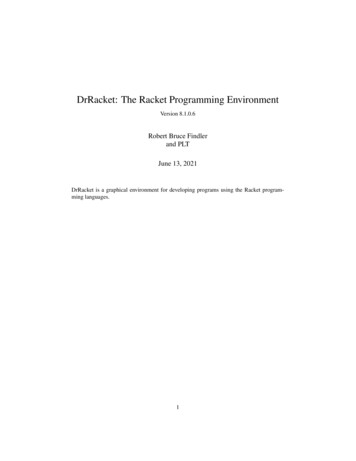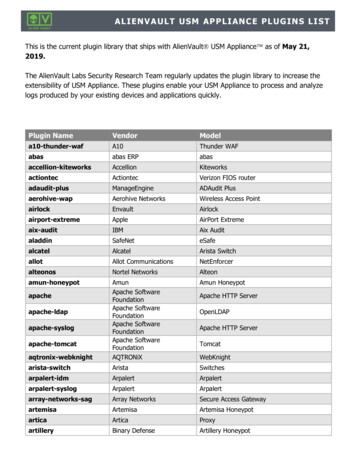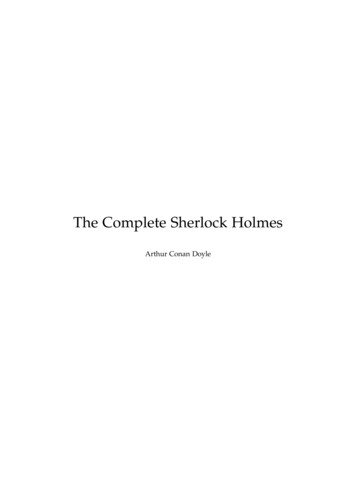
Transcription
DrRacket PluginsVersion 6.9Robert Bruce FindlerMay 1, 2017(require drracket/tool-lib)(require drracket/tool)(require drscheme/tool-lib)(require drscheme/tool)package:drracketThis manual describes DrRacket’s plugins interface. It assumes familiarity with Racket, asdescribed in the The Racket Guide, and the The Racket Reference, DrRacket, as describedin DrRacket: The Racket Programming Environment and the GUI library, as described in TheRacket Graphical Interface Toolkit. The Framework, as described in Framework: RacketGUI Application Framework, may also come in handy.The drscheme/tool-lib and drscheme/tool libraries are for backward compatibility;they export all of the bindings of their drracket counterpart.1
Contents1DrRacket support for #lang-based Languages1.1 Syntax Coloring . . . . . . . . . . . . . . . . . .1.2 Indentation . . . . . . . . . . . . . . . . . . . .1.3 Keystrokes . . . . . . . . . . . . . . . . . . . . .1.4 Filename Extensions . . . . . . . . . . . . . . .1.5 REPL Submit Predicate . . . . . . . . . . . . . .1.6 Show big “Definitions” and “Interactions” labels1.7 Opting out of Standard Toolbar Buttons . . . . .1.8 Opting in to Language-Specific Toolbar Buttons .1.9 Adding New Toolbar Buttons . . . . . . . . . . .1.10 Definitions Text Surrogate . . . . . . . . . . . .566777889992Implementing DrRacket Plugins113Adding Languages to DrRacket3.1 Adding Module-based Languages to DrRacket . . . . . . . . . . . . . . . .3.2 Adding Arbitrary Languages to DrRacket . . . . . . . . . . . . . . . . . .3.3 Language Extensions . . . . . . . . . . . . . . . . . . . . . . . . . . . . .161617184Creating New Kinds of DrRacket Frames205Extending the Existing DrRacket Classes216Expanding the User’s Program Text and Breaking227Editor Modes7.1 Color Schemes . . . . . . . . . . . . . . . . . . . . . . . . . . . . . . . .7.2 General-purpose Modes . . . . . . . . . . . . . . . . . . . . . . . . . . . .2323238Plugin Capabilities249Check Syntax9.1 Check Syntax Button . . . . . . . . . . . . . . . . . . . . . . . . . . . . .9.2 Syntax Properties that Check Syntax Looks For . . . . . . . . . . . . . . .25252510 Cooperating with Background Check Syntax3111 Teaching Languages3212 Signatures3313 drracket:get/extend3414 drracket:unit382
15 drracket:language5516 drracket:language-configuration8317 drracket:debug8618 drracket:rep9319 drracket:frame10220 drracket:help-desk10721 drracket:eval10822 drracket:modes11323 drracket:module-language-tools11524 drracket:module-language11925 drracket:tracing12126 Backwards Compatibility122Index150Index1503
ThanksThanks to PLT and the early adopters of the tools interface for their feedback and help.A special thanks to Eli Barzilay, John Clements, Matthias Felleisen, Cormac Flanagan,Matthew Flatt, Max Hailperin, Philippe Meunier, and Christian Queinnec for their help beingearly clients for DrRacket plugins.4
1DrRacket support for #lang-based LanguagesThe simplest and best way to extend DrRacket with support for a new language is to implement the language via #lang (see §17.3 “Defining new #lang Languages” for more details).DrRacket will then use read-language to find code and values that it uses to customize itself to the language.If the call to read-language raises an error, DrRacket logs the error at the debug level toa logger with the name 'drracket-language (see §15.5 “Logging” for more about how tofollow specific loggers).With the exception of the 'definitions-text-surrogate, if there is an error during ause of one of these extensions, DrRacket notices the error and removes all of the extensionsfor the language. It also shows the error at the bottom of the DrRacket frame (prefixed by#lang). Note that this applies only to errors that occur during the dynamic extent of a useof one of these extensions. If an extension were to, for example, create a new thread that(eventually) caused an error, DrRacket would not notice that error and would not remove theextensions.When experimenting with changes to these extensions, use the Racket Reload #lang extensions menu item to cause DrRacket to remove the extensions and reload the implementationsfrom the files on disk.DrRacket calls the language’s read-language’s get-info procedure with the followingkey arguments: drracket:default-filters drracket:default-extension drracket:indentation drracket:keystrokes drracket:show-big-defs/ints-labels drracket:opt-out-toolbar-buttons drracket:opt-in-toolbar-buttons drracket:submit-predicate drracket:toolbar-buttons color-lexer definitions-text-surrogate5
1.1Syntax ColoringWhen a language’s get-info procedure responds to 'color-lexer, it is expected to returna procedure suitable to pass as the get-token argument to start-colorer.The recognized token styles (specified implicitly via start-colorer’s token-sym style argument) are: 'symbol 'keyword 'comment 'string 'constant 'parenthesis 'error 'otherThese precise colors for these identifiers are controlled by the preferences dialog in DrRacket.1.2IndentationWhen a language’s get-info procedure responds to 'drracket:indentation, it is expected to return a function with this contract:(- (is-a?/c racket:text % )exact-nonnegative-integer?(or/c #f exact-nonnegative-integer?))The function is used to indent lines in DrRacket. It is called with the position containingthe line to be indented. It is expected to return the number of spaces that should appear atthe beginning of the line or #f. If #f is returned, DrRacket uses the standard s-expressionindentation rules.Added in version 1.3 of package drracket.6
1.3KeystrokesWhen a language’s get-info procedure responds to 'drracket:keystrokes, it is expected to return a list of keybindings and callbacks matching this contract:(listof (list/c string?(- (is-a?/c text%)(is-a?/c event%)any)))Each element of the list is a different keybinding, where the string indicates the keystroke(see the documentation for map-function for the precise contents of the string and how itmaps to particular keystrokes) and the procedure is called when the user types that keystrokein the definitions window.The procedure’s first argument will be the definitions text, the second will be the event objectsupplied from the GUI system and the result of the procedure is ignored.1.4Filename ExtensionsWhen a language’s get-info procedure responds to 'drracket:default-filters, it isexpected to return (listof (list/c string? string?)).These results are added as a prefix to finder:default-filters, extending the defaultthat DrRacket normally uses, namely: (["Racket Sources" "*.rkt;*.scrbl;*.rktl;*.rktd;*.ss;*.scm"]["Any" "*.*"])Added in version 1.2 of package drracket.When a language’s get-info procedure responds to 'drracket:default-extension,it is expected to return (and/c string? (not/c #rx"[.]")); the result is used as thedefault extension when saving files by setting finder:default-extension.Added in version 1.2 of package drracket.1.5REPL Submit PredicateWhen using the language declared in the source, DrRacket queries that language viaread-language to determine if an expression in the interactions window is ready to besubmitted to the evaluator (when the user types return). The info procedure is passed'drracket:submit-predicate and should return a function matching this contract:7
(- input-port?boolean?boolean?)This function’s first argument is a port that contains the interactions window’s data, startingjust after the prompt and continuing to the end of the editor. The second argument is aboolean indicating if the insertion point is followed only by whitespace. The results shouldbe a boolean indicating if the expression should be evaluated.For backwards compatibility reasons, DrRacket also queries the result of module language-info for 'drracket:submit-predicate. It does this during the evaluationof the definitions (so the Racket Reload #lang extensions menu item does not trigger are-load). If the submit predicate is specified both ways, then the predicate supplied viaread-language takes precedence.Changed in version 1.5 of package drracket: Look for drracket:submit-predicate via read-language.1.6Show big “Definitions” and “Interactions” labelsIf the read-language predicate returns #t for 'drracket:show-big-defs/intslabels, then DrRacket shows the words “Definitions” and “Interactions” in a large fontin the corresponding windows. This is intended as a help for students who are reading instructions about where to type their programs but might not have internalized this particularbit of DrRacket terminology.1.7Opting out of Standard Toolbar ButtonsSome of the built-in buttons in the DrRacket button bar at the top of the window can bedisabled on a per-language basis. DrRacket will invoke the get-info proc returned byread-language with 'drracket:opt-out-toolbar-buttons (and 'drscheme:optout-toolbar-buttons for backwards compatibility).If the result is a list of symbols, the listed symbols are opted out. If the result is #f, allbuttons are opted out. The default is the empty list, meaning that all opt-out buttons appear.The Check Syntax button uses the symbol 'drracket:syncheck; the debugger uses thesymbol 'debug-tool and the macro stepper uses 'macro-stepper.Plugins may add more opt-out buttons via button.8
1.8Opting in to Language-Specific Toolbar ButtonsLike drracket:opt-out-toolbar-buttons, but for languages to opt in to buttons thatare not enabled by default.Plugins may add more opt-out buttons via utton.Added in version 1.6 of package drracket.1.9Adding New Toolbar ButtonsDrRacket queries the result of read-language to determine if there are any new toolbarbuttons to be used when editing files in this language.Specifically, DrRacket will pass 'drracket:toolbar-buttons to the function and expectback a value matching this contract:(or/c (listof (list/c string?(is-a?/c bitmap%)(- (is-a?/c drracket:unit:frame % ) any)(or/c real? #f)))#f)which is then used to create new toolbar buttons, one for each element in the result list.The string is the label on the button; the bitmap is the icon (it should be 16x16 pixels); thefunction is called when the button is clicked; and the number is passed as the #:numberargument to register-toolbar-button.If the result is #f, then no toolbar buttons are created.To implement functionality similar to the Run button, call the execute-callback method.You may also want to use the drracket:rep:after-expression parameter.If 'drracket:toolbar-buttons is not recognized, DrRacket will also pass'drscheme:toolbar-buttons; this is for backwards compatibility and new codeshould not use it. Similarly, if the fourth element from the list (the argument to #:number)is not present, then it is treated as #f.1.10Definitions Text SurrogateUsing a #lang-specific definitions text surrogate is a very powerful way to flexibly controlDrRacket’s behavior when a new language is installed. It is also easy to cause DrRacket9
to completely misbehave with this form of extension. It is here only when one of the otherforms of extension listed above are not sufficient for the kind of extension your languagerequires. And even in that case, it is preferable to add something to this list that is moreeasily controlled in the case of errors, using the definitions text surrogate only until thatmore easily controlled extension has been added to DrRacket.DrRacket calls read-language’s get-info procedure with 'definitions-textsurrogate and expects it to return a value matching the contract (or/c #f modulepath?), which is then passed to dynamic-require together with 'surrogate%. The resultis expected to be a class implementing the interface racket:text-mode % (presumablyderived from racket:text-mode%. That mode is installed into the definitions text, whereit can change its behavior by changing how is responds to any of the methods in the mode.One consequence of this power is that errors that happen during the dynamic extent of callsinto the mode are not trapped (much as errors that occur on newly created threads are nottrapped, as described in the introduction to this section).10
2Implementing DrRacket PluginsPlugins are designed for major extensions in DrRacket’s functionality. To extend the appearance or the functionality the DrRacket window (say, to annotate programs in certain ways orto add buttons to the DrRacket frame) use a tool. The Macro Stepper, the Syntax Checker,the Stepper, and the teaching languages are all implemented as tools.When DrRacket starts up, it looks for tools by reading fields in the info.rkt file of eachcollection and the newest version of each PLaneT package installed on the system. (Technically, DrRacket looks in a cache of the "info.rkt" files contents created by raco setup.Be sure to re-run raco setup if you change the contents of the info.rkt files). DrRacketchecks for these fields: drracket-tools: (listof (listof string [subcollection-name])) drracket-tool-names: (listof (or/c #f string)) drracket-tool-icons:(listof (or/c #fstring[relative-pathname](cons string[filename](listof string[collection-name])))) drracket-tool-urls: (listof (or/c #f string [url]))The drracket-tools field names a list of tools in this collection. Each tool is specified asa collection path, relative to the collection where the info.rkt file resides. As an example,if there is only one tool named tool.rkt, this suffices:(define drracket-tools (list (list "tool.rkt")))If the drracket-tool-icons or drracket-tool-names fields are present, they must bethe same length as drracket-tools. The drracket-tool-icons field specifies the pathto an icon for each tool and the name of each tool. If it is #f, no tool is shown. If it is arelative pathname, it must refer to a bitmap and if it is a list of strings, it is treated the sameas the arguments to lib, inside require.This bitmap and the name show up in the about box, the bug report form, and the splashscreen as the tool is loaded at DrRacket’s startup.Each of the drracket-tools files must contain a module that provides tool@, whichmust be bound to a unit. The unit must import the drracket:tool signature, whichis provided by the drracket/tool library. The drracket:tool signature contains allof the names listed in this manual. The unit must export the drracket:tool-exports signature.11
If the tool raises an error as it is loaded, invoked, or as the phase1 or phase2 thunks arecalled, DrRacket catches the error and displays a message box. Then, DrRacket continues tostart up, without the tool.For example, if the info.rkt file in a collection contains:#lang info(define drracket-tool-names (list "Tool Name"))(define drracket-tools (list (list "tool.rkt")))then the same collection would be expected to contain a tool.rkt file. It might containsomething like this:#lang racket/gui(require drracket/tool)(provide tool@)(define tool@(unit(import drracket:tool )(export drracket:tool-exports )(define (phase1) (message-box "tool example" "phase1"))(define (phase2) (message-box "tool example" "phase2"))(message-box "tool example" "unit invoked")))This tool just opens a few windows to indicate that it has been loaded and that the phase1and phase2 functions have been called.Finally, here is a more involved example. This module defines a plugin that adds a buttonto the DrRacket frame that, when clicked, reverses the contents of the definitions window.It also adds an easter egg. Whenever the definitions text is modified, it checks to see if thedefinitions text contains the text “egg”. If so, it adds “easter ” just before.#lang racket/base(require tmrlib/switchable-button)(provide tool@)(define secret-key "egg")(define to-insert "easter ")(define tool@12
(unit(import drracket:tool )(export drracket:tool-exports )(define easter-egg-mixin(mixin ((class- interface text%)) ()(inherit )key)))key)))(define/augment (on-insert start len)(begin-edit-sequence))(define/augment (after-insert start len)(check-range (max 0 (- start (string-length secret( start len))(end-edit-sequence))(define/augment (on-delete start len)(begin-edit-sequence))(define/augment (after-delete start len)(check-range (max 0 (- start (string-length secretstart)(end-edit-sequence))(define/private (check-range start stop)(let/ec k(for ((x (in-range start stop)))(define after-x(get-text x ( x (string-length secret-key))))(when (string ? after-x secret-key)(define before-x(get-text (max 0 (- x (string-length toinsert))) x))(unless (string ? before-x to-insert)(insert to-insert x x)(k (void)))))))(super-new)))(define reverse-button-mixin(mixin (drracket:unit:frame % ) ()(super-new)13
(inherit get-button-panelget-definitions-text)(inherit register-toolbar-button)(let ((btn(new switchable-button%(label "Reverse Definitions")(callback (λ parent (get-button-panel))(bitmap reverse-content-bitmap))))(register-toolbar-button btn #:number 11)(send (get-button-panel) change-children(λ (l)(cons btn (remq btn l)))))))(define reverse-content-bitmap(let* ((bmp (make-bitmap 16 16))(bdc (make-object bitmap-dc% bmp)))(send bdc erase)(send bdc set-smoothing 'smoothed)(send bdc set-pen "black" 1 'transparent)(send bdc set-brush "blue" 'solid)(send bdc draw-ellipse 2 2 8 8)(send bdc set-brush "red" 'solid)(send bdc draw-ellipse 6 6 8 8)(send bdc set-bitmap #f)bmp))(define (reverse-content text)(for ((x (in-range 1 (send text last-position))))(send text split-snip x))(define snips(let loop ((snip (send text find-first-snip)))(if snip(cons snip (loop (send snip next)))'())))(define released-snips(for/list ((snip (in-list snips))#:when (send snip release-from-owner))snip))(for ((x (in-list released-snips)))(send text insert x 0 0)))(define (phase1) (void))14
(define (phase2) t frame reverse-button-mixin)))15
33.1Adding Languages to DrRacketAdding Module-based Languages to DrRacketFor backwards compatibility, DrRacket also supports and info.rkt file-based method forspecifying such languages. Include these definitions: drscheme-language-modules: This must be bound to a list of collection path specifications or strings, one for each language in the collection. Each collection pathspecification is the quoted form of what might appear as an argument to require,using the lib argument (but without the lib). The strings represent relative pathsstarting at the directory containing the info.rkt file. They are interpreted like stringarguments to require. drscheme-language-positions: This must be bound to a list of language positions. Each language position corresponds to the position of the language in languagedialog. Each language position is a list of strings whose length must be at least two.If the first string is the same as (string-constant teaching-languages), thenit is put into the “Teaching Languages” section of the dialog. Otherwise, it goes intothe “Other Languages” section of the dialog. get-drscheme-language-positions: This must be bound to a list that containsa module path followed by a symbol. The module path and symbol are combinedwith dynamic-require to obtain a list that is appended to the one from drschemelanguage-positions, which allows access to string-constants to specify language positions. drscheme-language-numbers: This is optional. If present, it must be a list of alist of numbers. Each list corresponds to a single language from this collection. Eachnumber indicates a sorting order in the language dialog for the corresponding string indrscheme-language-positions. If absent, it defaults to a list of zeros that has thes
15 drracket:language 55 16 drracket:language-configuration 83 17 drracket:debug 86 18 drracket:rep 93 19 drracket:frame 102 20 drracket:help-desk 107 21 drracket:eval 108 22 drracket:modes 113 23 drracket:module-language-tools 115 24 drracket:module-language 119










